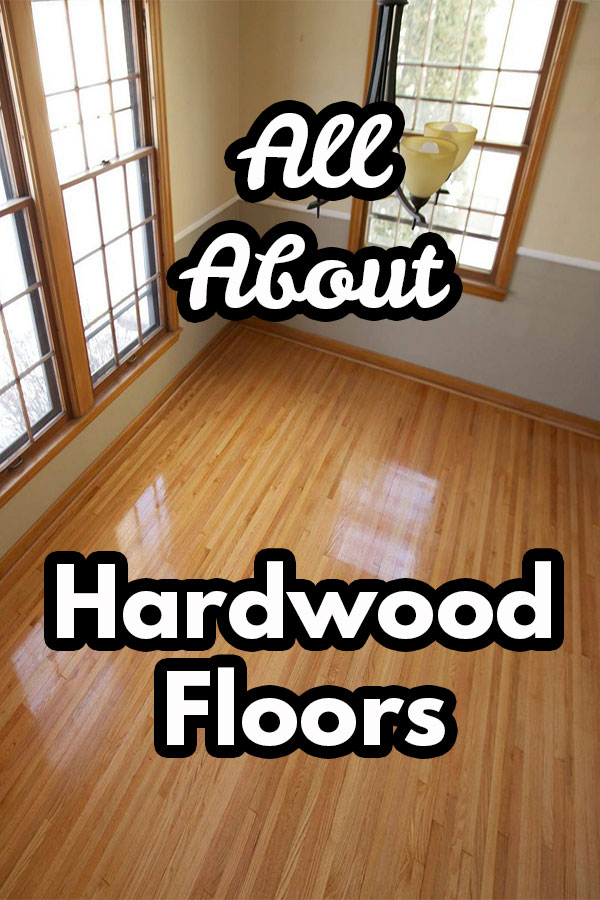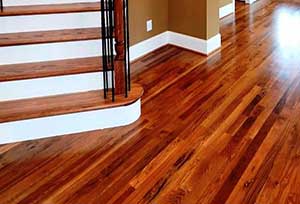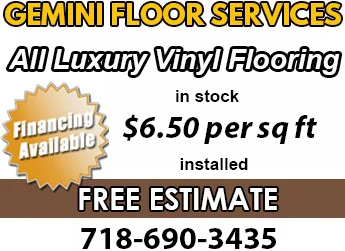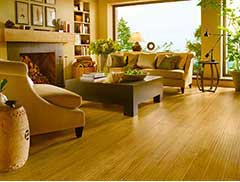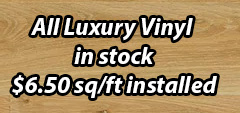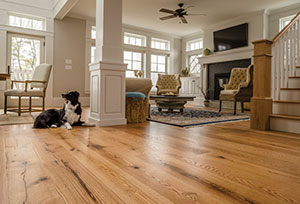 Hardwood flooring is an old time classic that’s the top choice for many homeowners. Who doesn’t love the natural beauty & richness of a solid wood floor ? Every wood floor is unique as no floor boards are exactly the same. The variety of species, grain patterns, stain colors & board widths offers choices for every taste. Most common in living rooms, dining rooms & bedrooms, hardwood can be installed anywhere free of high humidity or excess moisture. With proper care hardwood flooring can last a lifetime. Some of the hardwood floors we’ve refinished in Brooklyn brownstones are over 100 years old.
Hardwood flooring is an old time classic that’s the top choice for many homeowners. Who doesn’t love the natural beauty & richness of a solid wood floor ? Every wood floor is unique as no floor boards are exactly the same. The variety of species, grain patterns, stain colors & board widths offers choices for every taste. Most common in living rooms, dining rooms & bedrooms, hardwood can be installed anywhere free of high humidity or excess moisture. With proper care hardwood flooring can last a lifetime. Some of the hardwood floors we’ve refinished in Brooklyn brownstones are over 100 years old.
Types of Hardwood Flooring
Natural hardwood flooring is available in numerous species which vary in hardness, color and grain pattern. Many common types of wood are grown in the US (domestics) like oak, maple, hickory, cherry & walnut. Species grown outside the US are called exotic. Red Oak is the most common domestic because it’s abundant and ideal for hardwood flooring. It’s affordable, beautiful, stains well and has the right amount of hardness to make it durable yet easy to work with.
The harder the wood the more it resists dents & scratches, so it can last longer. Harder wood is more dense and takes longer to grow and renew. It requires more labor to cut, install, sand & stain. Though it is more costly for material & labor, the lifetime costs may be reduced by the fact that it can last longer and need refinishing less often. That’s one of the great advantages of hardwood flooring is that it can be sanded & refinished multiple times to make it look new again.
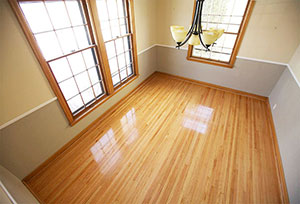 Softer wood types are less dense, grow faster and are thus more renewable and less costly. They are however more prone to dents & scratches. They could require refinishing more often. Some folks may still prefer a softer species of wood because of the beauty & price. Price of hardwoods range $5-$15 square/ft, $7-$23 installed.
Softer wood types are less dense, grow faster and are thus more renewable and less costly. They are however more prone to dents & scratches. They could require refinishing more often. Some folks may still prefer a softer species of wood because of the beauty & price. Price of hardwoods range $5-$15 square/ft, $7-$23 installed.
Wood species are rated on what is called the Janka hardness scale. These are some of the more common wood species from softest to hardest: (Ten Most Common Types of Hardwood Floors)
Douglas Fir 660
White Pine 690
Black Cherry 950
Black Walnut 1010
Teak 1078
Heart Pine 1225
Birch 1260
Red Oak 1290
Beech 1300
White Ash 1320
White Oak 1360
Australian Cypress 1375
Maple 1450
Hickory/ Pecan 1820
Jarrah 1910
Mahogany 2200
Mesquite 2345
Brazilian Cherry 2820
Purpleheart 2890
Brazilian Teak 3540
Brazilian Walnut 3680
Engineered Hardwood Flooring
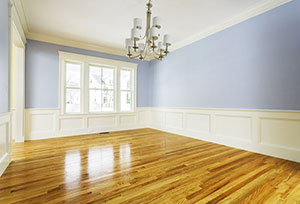 Many species of hardwood are available as engineered hardwood. A layer of solid hardwood is bonded with other reinforced layers made with wood fiber & adhesive. Engineered wood is more resistant to humidity & moisture. It is not prone to expansion & contraction caused by high humidity & temperature changes as is solid hardwood. Expansion & contraction can cause floor boards to warp & form gaps.
Many species of hardwood are available as engineered hardwood. A layer of solid hardwood is bonded with other reinforced layers made with wood fiber & adhesive. Engineered wood is more resistant to humidity & moisture. It is not prone to expansion & contraction caused by high humidity & temperature changes as is solid hardwood. Expansion & contraction can cause floor boards to warp & form gaps.
Engineered wood is suitable for areas exposed to moisture like bathrooms, mudrooms, laundry rooms & basements below grade. Unlike solid hardwood it can be installed below ground level and directly on concrete subfloors with or without plywood. A moisture barrier should be used, which also makes the floor quieter to walk on. Engineered wood is also ideal for radiant floor heating.
Though engineered wood costs less, the disadvantage is it can’t be refinished as many times as hardwood, so it may not last as long. Some engineered floors can be refinished 1-3 times depending on how thick the top layer of hardwood is. The cheapest stuff has the thinnest layer. Look for a minimum half inch hardwood layer to be able to sand & refinish at least once or twice. The cost ranges $3-$5 square/ft, $6-$15 installed.
Cork Flooring
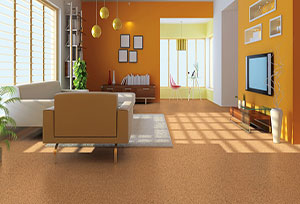 Cork is another flooring option. It’s made from bark. Cork is bonded under high pressure with adhesive resins. It’s also available in solid or engineered construction. It’s eco friendly & very renewable since the tree is not cut & the bark can be reharvested every several years. Cork flooring is quiet & soft to walk on. It is resistant to moisture, mold & mildew, though exposure to excess water should be avoided. Cork can come prefinished or can be site finished & refinished just like hardwood. It is less resistant to dents & scratches than engineered or hardwood flooring. Thus it is not recommended for pet owners because pet nails can puncture & scratch the surface. The cost ranges $3-$8 square/ft, $5-$11 installed.
Cork is another flooring option. It’s made from bark. Cork is bonded under high pressure with adhesive resins. It’s also available in solid or engineered construction. It’s eco friendly & very renewable since the tree is not cut & the bark can be reharvested every several years. Cork flooring is quiet & soft to walk on. It is resistant to moisture, mold & mildew, though exposure to excess water should be avoided. Cork can come prefinished or can be site finished & refinished just like hardwood. It is less resistant to dents & scratches than engineered or hardwood flooring. Thus it is not recommended for pet owners because pet nails can puncture & scratch the surface. The cost ranges $3-$8 square/ft, $5-$11 installed.
Bamboo Flooring
Bamboo flooring has many similar qualities as hardwood though it’s actually a type of grass shoot. It’s considered eco friendly because it grows rapidly and is easily renewable. Bamboo strips are adhered together into planks. It is harder than many hardwoods and thus as durable & scratch resistant. High quality bamboo can last as long as hardwood and also be refinished several times, though it also can be damaged by excess moisture. Bamboo is available in a wide variety, prefinished & unfinished. Like any product which includes adhesive, VOC’s can be a factor and it’s important to look for products that have air quality certifications. Many of the inexpensive products do not. Bamboo is also resistant to mold & allergens. The cost ranges $3-$8 square/ft, $7-$12 installed.
Laminate & Vinyl
Laminate & vinyl are flooring materials that can look like real wood. These have a photographic image applied to layered materials like wood pulp fiberboard or pvc plastic. These are less expensive than hardwood & can’t be refinished when the surface is worn. Laminate or vinyl can look great but aren’t as long lasting as hardwood. The costs range $1-$7 square/ft, $2-$15 installed.
Hardwood Flooring Options
• Prefinished or unfinished: prefinished planks are best for DIY projects. The planks come already stained & topcoat sealed with uv protected polyurethane. Some high quality prefinishes include aluminum oxide & can be more durable & resistant to UV fading. The material cost is higher but if you’re having professional installation the cost usually balances out with labor costs saved by quicker installation. With prefinished planks installation is quicker & you know before hand exactly what the flooring will look like. With site finishing there is more color choices but more variable in how the finished floor will look. On site stain tests with several colors will give a better idea of the finished look. On site finishing will offer more protection to the floor from moisture because all the seams are sealed. Prefinished planks will leave seams where spills can possibly penetrate.
• Finish with penetrating oil, oil based polyurethane or water based polyurethane. Penetrating oil is the easiest for DIY but it isn’t a hard protective coat like polyurethane. Penetrating oil will leave the surface more susceptible to dents & scratches, though it hides scratches better & is much easier to reapply & patch up small areas.
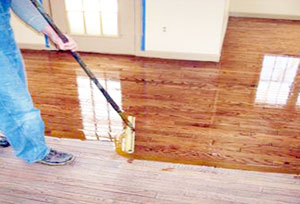 Polyurethane is the most common floor finish & is available in oil base or water base. Either type will create a hard protective coat. Oil base is less expensive & more DIY friendly because it takes longer to dry, so it is easier to correct mistakes when applying. Compared to water base it can take a few more days to cure before placing furniture. Noxious fumes are the main drawback with oil base. A respirator should be used and fumes can linger for days or weeks. Oil base polyurethane changes the color of the wood when applied & overtime it continues to ‘amber’, changing to a darker color.
Polyurethane is the most common floor finish & is available in oil base or water base. Either type will create a hard protective coat. Oil base is less expensive & more DIY friendly because it takes longer to dry, so it is easier to correct mistakes when applying. Compared to water base it can take a few more days to cure before placing furniture. Noxious fumes are the main drawback with oil base. A respirator should be used and fumes can linger for days or weeks. Oil base polyurethane changes the color of the wood when applied & overtime it continues to ‘amber’, changing to a darker color.
Some flooring pros believe oil base to be longer lasting while some contend a high quality water base lasts just as long which can be about 10 years. Water base finish is more expensive but curing time is considerably less. It’s possible to apply three coats & walk on it the same day. Less return trips for professional application means the cost could be about the same as oil base. Because it dries quickly it requires professional application. The other main advantage is very low odor. In New York City apartment & condo buildings water base is required because of the lingering odor & VOC’s with oil base. Water base dries clear and maintains the natural color of the wood without changing color over time.
• Plank Width
Standard planks are typically under 3.5 inches. Wider planks have grown in popularity & are considered to add style. Board width is simply a style preference. The functionality is the same. Some floors use several board widths for a unique style. Wide planks range from 6 to 11 inches & generally the wider the plank the more costly. The only drawback of wide boards is that any gaps that may form overtime with exposure to humidity & temperature changes will be more obvious since there are less boards to distribute the space.
• Wood Grade
Planks are available in different grades according to how many defects there are. The planks are sorted at the mill & the ones with the least defects are the most costly. Low grade planks are cheaper but can be a great choice for rustic settings. Some planks with alot of knots are low grade depending on the wood species. With some types of wood more knots goes with the higher grade. Reclaimed wood is another option where used planks are preserved & reused. Such planks can add an aged, historic look. Though reclaimed wood is used, it is not cheap because of the labor involved in reclaiming it.
• Grain Patterns
Planks are available with different angle cuts, namely plain (flat) sawn, quarter sawn & rift sawn. Each exposes the grain from a different angle. The different cuts give the wood a different look as well as different durability qualities. Plain sawn – most common, least expensive, beautiful grain patterns/ quarter sawn – more expensive, more stable, straight grain / rift sawn – most expensive, least common, strongest boards
• Hardwood Flooring Textures
Traditionally floor planks are sanded to a smooth surface, which goes well with most settings. But today there are several choices of texture like scraped, wire brushed & distressed wood. These are features that can add character to various styles whether it be contemporary, traditional, rustic, industrial or eclectic. With such textured wood small dents & scratches will blend in & the floors will still look great after years. On smooth finished floors dents & scratches will show more.
• Finish Color
Hardwood flooring planks are available prefinished in a variety of colors. Wood stains for unfinished planks offer an even wider variety of natural colors in shades of brown, yellow, grey, tan & red. Planks can also be painted any color imagineable. Lighter stain colors tend to show less dirt while darker colors hide the grain pattern more, giving a more uniform look.
• Gloss Level
Polyurethane finishes come in at least 4 different levels of sheen. Glossy or high gloss has the most shine at 70%. Glossy reflects the most light, but also shows dirt & scratches the most. Semigloss has 55% sheen & satin has 40%. Satin is the most popular as it has just enough shine while not showing dirt, dents & scratches too much. It looks classy, is easy to keep looking clean & stays new looking for longer. Matte has 25% sheen which some like because it looks clean, though it doesn’t have much sheen.
• Custom Design Patterns
Hardwood flooring installations can be embellished with various design patterns, borders, inlays & medallions. Straight boards, diagonal, zigzag (herringbone) pattern, alternating parallel & horizontal (parquet), random board width & basket weaves are some of the possible design patterns. There’s also different border patterns like the popular Greek key design. Medallions & other intricate designs can make a hardwood floor look like it’s made for a royal palace.
Installation of Hardwood Flooring
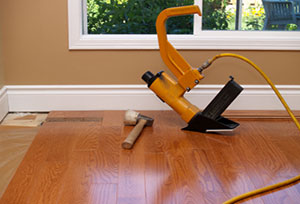 If you are wanting solid hardwood flooring, in most cases installation is best left to a professional. Seasoned DIYers may attempt to install it and prefinished hardwood can make it easier. But hardwood needs to be fastened down with nails or staples to a plywood subfloor with proper leveling & spacing. The tools & skills required make it a worthy investment to hire a professional. Professional installation offers warranties & ensures proper installation to get the most out of your floor. Improper installation can result in gaps, cracks, warping & squeaking. Keep in mind that solid hardwood can only be installed at or above grade. For sanding & refinishing it’s also best to hire a pro. For DIY floor installation, easy snap together click lock floating floor planks are available for engineered wood, bamboo, cork, laminate & vinyl. (Flooring Comparison Chart)
If you are wanting solid hardwood flooring, in most cases installation is best left to a professional. Seasoned DIYers may attempt to install it and prefinished hardwood can make it easier. But hardwood needs to be fastened down with nails or staples to a plywood subfloor with proper leveling & spacing. The tools & skills required make it a worthy investment to hire a professional. Professional installation offers warranties & ensures proper installation to get the most out of your floor. Improper installation can result in gaps, cracks, warping & squeaking. Keep in mind that solid hardwood can only be installed at or above grade. For sanding & refinishing it’s also best to hire a pro. For DIY floor installation, easy snap together click lock floating floor planks are available for engineered wood, bamboo, cork, laminate & vinyl. (Flooring Comparison Chart)
Installation of Engineered Hardwood Flooring
The advantage of engineered wood flooring is it offers more versatile installation options. It can be fastened, glued or floated. This makes it ideal for DIY installation. Engineered wood can be installed at, above or below grade. It can be glued, nailed or stapled to a plywood subfloor. It can also be installed without a plywood subfloor.
A click lock floating floor can be installed over any type of subfloor like tile, vinyl or concrete. Floating floor installation does not require any glue or fasteners to adhere to the subfloor. The floor boards simply ‘float’ over or lay on top of the subfloor. They’re secured together by click lock fasteners that snap together, or by a thin strip of glue placed on the tongue & groove.
Engineered floors can be installed on concrete & in below ground basements where there’s moisture. It can be glued down on to fully cured concrete, tile or onto a pad placed over the subfloor. Padding provides softness, quietness & serves as a moisture barrier. In all cases the subfloor must be dry & flat for a successful installation. Keep in mind floor height & door clearances when installing over existing materials.
Hardwood Flooring Maintenance
 Hardwood & Engineered wood floors are relatively easy to maintain. The main thing is sweep or vacuum regularly to remove dirt & grit which can wear the topcoat. Use the vacuum hose & soft attachments to avoid running abrasive vacuum bristles on the floor. Use doormats in entryways & area carpets in high traffic areas. Removing shoes in the house is not a must but it does help keep floors looking new for longer. High heals though should be removed as they can dent the floor. Put felt pads on furniture legs to protect floors from scratches. Avoid excess water on the floor. Don’t let water sit. Do not wet mop, rather use a damp mop or cloth. Avoid harsh cleaners & chemicals, ammonia & even vinegar. Some products can damage the finish. Use cleaning products designed for hardwood floors, generally spray on products that don’t require much water. Sanding & refinishing is generally done about every 7-10 years to renew the floors & remove dents & scratches.
Hardwood & Engineered wood floors are relatively easy to maintain. The main thing is sweep or vacuum regularly to remove dirt & grit which can wear the topcoat. Use the vacuum hose & soft attachments to avoid running abrasive vacuum bristles on the floor. Use doormats in entryways & area carpets in high traffic areas. Removing shoes in the house is not a must but it does help keep floors looking new for longer. High heals though should be removed as they can dent the floor. Put felt pads on furniture legs to protect floors from scratches. Avoid excess water on the floor. Don’t let water sit. Do not wet mop, rather use a damp mop or cloth. Avoid harsh cleaners & chemicals, ammonia & even vinegar. Some products can damage the finish. Use cleaning products designed for hardwood floors, generally spray on products that don’t require much water. Sanding & refinishing is generally done about every 7-10 years to renew the floors & remove dents & scratches.
(Hardwood Floor Maintenance Guide)
Solid Hardwood Flooring Pros & Cons
- can last a lifetime, some floors over 100 years (depending on wood species, maintenance & traffic
- can be refinished multiple times to make floor look new again
- can change sheen level & color when refinishing
- adds beauty & resale value to any home• hypoallergenic, resists mold & allergen
- 100% natural
- easy to maintain
- can be more costly than other flooring types
- excess moisture or humidity can damage floors
- not easy for DIY installation
- not easy to replace a damaged section like a floating floor is
Engineered Hardwood Flooring Pros & Cons
- water resistant, suitable for bathrooms, basements, laundry & mudroom
- click lock floating floor installation easy for DIY
- many installation options
- better for radiant heated flooring
- generally less costly than solid hardwood
- all natural except adhesives, check for air quality certification
- easy to maintain
- hypoallergenic, resists mold & allergens
- floating floor easy to replace a damaged section
- can’t be refinished as many times as solid hardwood, may not last as long (20-80 years)
Factors To Consider When Buying Hardwood Flooring
- DIY or pro installation
- species
- solid or engineered
- finished or prefinished
- type of finish: penetrating oil, oil base or water base polyurethane
- sheen level
- hardness
- price
- color
- texture
- grain pattern
- borders, patterns, medallions
- plank width & length
- warranty
Contact Gemini Floor Services today to schedule a free consultation for hardwood floor installation in your home or business. 718-690-3435. Visit us at our showroom at 119 Schenectady Ave, Brooklyn NY 11213
